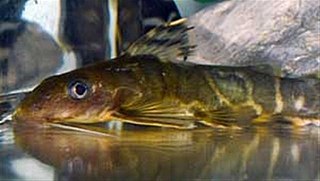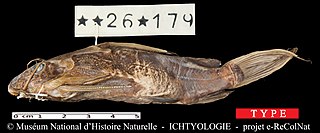
Microsynodontis is a genus of upside-down catfishes native to freshwater rivers in western Africa. The genus was originally described by British-Belgian zoologist George Albert Boulenger in 1903 based upon the type species Microsynodontis batesii. The name microsynodontis comes from the Greek word mikro, meaning small, and the Greek term synodon, meaning "with the teeth all growing together".
Microsynodontis armatus is a species of upside-down catfish endemic to Gabon where it occurs in the Ivindo River. It was first described in 2004 by Ng Heok Hee.
Microsynodontis emarginata is a species of upside-down catfish endemic to Gabon where it occurs in the Ogowe River. It was first described in 2004 by Ng Heok Hee.
Microsynodontis hirsuta is a species of upside-down catfish endemic to Gabon where it occurs in the Ntem River. It was first described in 2004 by Ng Heok Hee.
Microsynodontis laevigata is a species of upside-down catfish endemic to Gabon where it is found in the Ivindo River. It was first described in 2004 by Ng Heok Hee.
Microsynodontis nannoculus is a species of upside-down catfish endemic to Equatorial Guinea where it occurs in the Kyé River. It was first described in 2004 by Ng Heok Hee.
Microsynodontis notata is a species of upside-down catfish endemic to Gabon where it occurs in the Ogowe River. It was first described in 2004 by Ng Heok Hee.
Microsynodontis vigilis is a species of upside-down catfish endemic to Gabon where it occurs in the Ogowe River. It was first described in 2004 by Ng Heok Hee.

Synodontis brichardi, known as Brichard's synodontis, is a species of upside-down catfish that is endemic to the Democratic Republic of the Congo where it occurs in the rapids of the lower Congo River. It was first described by Max Poll in 1959. The original specimens were obtained from the rapids at Kinsuka, Kinshaa, Zaire. The species name brichardi is named in honor of Pierre Brichard, an aquarium fish exporter who first discovered the fish.
Synodontis camelopardalis, known as the giraffe synodontis, is a species of upside-down catfish that is endemic to the Democratic Republic of the Congo where it is only known to occur in the Tshuapa River. It was first described by Max Poll in 1971. The original specimens were obtained in Eala, on the Ruki River in the central Congo River Basin. The species name camelopardalis refers to the giraffe, Giraffa camelopardalis, in reference to the coloration of the fish.

Synodontis caudalis, known as the filament tailed synodontis, or the whiptail synodontis, is a species of upside-down catfish native to the Democratic Republic of the Congo. It was first described by Belgian-British zoologist George Albert Boulenger in 1899, from specimens collected in what is now the Democratic Republic of the Congo. The species name caudalis comes from the Latin word cauda, meaning tail, and refers to the elongated filaments in the caudal fin of the species.

Synodontis centralis is a species of upside-down catfish that is endemic to the Democratic Republic of the Congo where it occurs in the middle Congo Basin. It was first described by Max Poll in 1971. The original specimens were obtained in Ndwa village, Kunungu, Zaire. The species name centralis refers to its habitat in the central Congo Basin.

Synodontis longirostris, known as the eyespot synodontis, is a species of upside-down catfish that is native to the Democratic Republic of the Congo where it occurs in the Congo Basin. It was first described by British-Belgian zoologist George Albert Boulenger in 1902, from specimens obtained in the Ubangi River at Banzyville. The species name longirostris comes from the Latin word longus, meaning "long", and the Latin word rostrum, meaning snout, referring to the long snout on this species.
Synodontis lufirae is a species of upside-down catfish that is endemic to the Democratic Republic of the Congo where it occurs in the Lufira River drainage. It was first described by Max Poll in 1971. The original specimens were obtained in the Lufira River, in the Congo River Basin. The species name lufirae is named for the river in which the species is found.

Synodontis multimaculatus, known as the dotted synodontis, is a species of upside-down catfish that is native to the Democratic Republic of the Congo where it is found in the Ubangi River. It was first described by British-Belgian zoologist George Albert Boulenger in 1902, from a specimen collected in the Ubangi River in Mobayi-Mbongo, the Democratic Republic of the Congo. The species name multimaculatus is derived from the word multi, meaning many, and the Latin word maculatus, meaning spots, referring to the many spots on the fish.

Synodontis nigromaculatus, known as the spotted squeaker, the blackspotted squeaker, or the speckled squeaker, is a species of upside-down catfish that is found widely in southern Africa. It has been identified in Angola, Botswana, the Democratic Republic of the Congo, Mozambique, Namibia, South Africa, Zambia, and Zimbabwe. It was first described by British-Belgian zoologist George Albert Boulenger in 1905, from specimens collected in Lake Bangweulu in Zambia.

Synodontis obesus, known as the Coas synodontis, is a species of upside-down catfish that is native to the coastal drainages of Cameroon, Ghana, Nigeria and Togo. It was first described by British-Belgian zoologist George Albert Boulenger in 1898. The species name obesus is derived from the Latin word obesus, meaning "fat".

Synodontis pardalis is a species of upside-down catfish that is endemic to Cameroon where it occurs in the Dja River drainage. It was first described by British-Belgian zoologist George Albert Boulenger in 1908, from specimens collected in the Dja River in southern Cameroon. The species name pardalis is derived from the Greek word pardalis, which means "leopard", which refers to the spotted pattern on the fish.

Synodontis robbianus, known as the russet synodontis, is a species of upside-down catfish that is native to Nigeria where it is found in the Cross and lower Niger Rivers. It was first described by John Alexander Smith in 1875, from specimens collected in the Calabar River, Nigeria. The species name robbianus is named after Rev. Alexander Robb, a Scottish missionary, who collected the original species samples.
Synodontis unicolor is a species of upside-down catfish that is endemic to the Democratic Republic of the Congo where it occurs in the area of Luapula-Mweru. It was first described by George Albert Boulenger in 1915. The original specimens were obtained in Kasenga, on the Luapula River in what is now the Democratic Republic of the Congo. The species name unicolor means "one color", referring to the uniform dark-brown coloration on the body and fins.
Boulenger, G.A. (1905) A list of freshwater fishes of Africa. Annals and Magazine of Natural History (Series 7),16, 36–6
Roberts, T. R. (1989) Systematic revision and description of new species of suckermouth catfishes (Chiloglanis, Mochokidae) from Cameroun. Proceedings of the California Academy of Sciences (Series 4), 46, 151–178.










